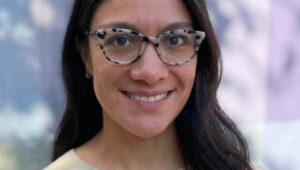A look at NAS’ experience with co-leadership
In the past half-decade it’s likely you’ve heard at least one of the buzzwords listed above. They relate to different leadership models that organizations are experimenting with, and their concepts are swirling around different industries, including arts and culture. One of the responses brought about by the global pandemic and society’s increased awareness of the racial injustices that plague the US and other countries has been an increased desire to move toward more shared leadership models and away from typical hierarchical organizational models. Leaders are reckoning with the reality that hierarchical structures may uphold the racist structures that many arts organizations were founded upon.
While shared leadership has been a hot topic in the NAS community, there is considerable debate about how effective and feasible it is to implement. Unfortunately, there is not a lot of research or examples from which to draw. (One notable exception is Fractured Atlas, who have written extensively about their experience with a four-person co-leadership model).
In the spirit of sharing learning, we wanted to write about our own experience with these models, which we’ve put in motion at NAS over the past several years. First we’ll start out with the history of shared leadership at NAS and go deeper about a recent experiment we conducted over the summer of 2022.
NAS has been practicing shared leadership and distributed leadership models for over six years and has been even more intentional about implementing these models in the last three years. You may be wondering what on earth the difference is. We’ll try our best to explain, at least in the way that NAS practices these leadership models.
- Distributed leadership is the idea that decision-making is dispersed among everyone on the team. For NAS, that means everyone is involved in the decision-making process from program coordinators to the senior leadership team.
- Shared leadership, on the other hand, is the sharing of power and influence, with one person remaining in charge. Ultimately, we combine these two leadership models which we have found to be an effective practice.
What We’ve Learned So Far
We’ve learned that, like any new endeavor, there are always pros and cons. From our experience, the biggest challenge is time. Things take longer to implement because of the time it takes to seek out and discuss everyone’s perspective or point of view. This level of collaboration can often create bottlenecks, hindering the ability to make timely decisions. Another challenge is that sometimes, our staff want to be told what to do to get things done more efficiently. However, we recognize that this is not always the most effective approach. Lastly, if you are not intentional, it can be difficult for team members to take accountability for specific tasks. We would be remiss if we didn’t acknowledge that having a small team plays a role in mitigating some of these challenges.
Despite these challenges, the benefits make implementing shared and distributed leadership models worthwhile. For starters, there is a greater distribution of knowledge across the team. We make more informed and innovative decisions because we consider a diverse set of perspectives; everyone on the team weighs in on most major decisions. Lastly, we’ve noticed that team members are more autonomous and feel more empowered to take on leadership roles – often doing what is needed without being told.
Although we have had great success implementing non-hierarchical leadership models, the reality is that even though all team members are involved in the decision-making process with shared and distributed leadership models, we know that the ultimate decision-maker is our president and CEO. These types of leadership models do not fully eliminate reliance on the leader.
Taking It to the Next Level
In the Spring of 2022, NAS’s president and CEO, Gail Crider, took a long-awaited sabbatical. Gail’s sabbatical presented an opportunity to experiment with how an organization would operate while not being dependent on any one leader. Instead of elevating one person to the main leadership role in Gail’s absence, the two of us — Vice President of Programs and Partnerships, Sunny Widmann, and our Vice President of Learning and Engagement, Dr. Deryn Dudley (co-writing this blog together) — stepped up to the plate and experimented with a co-leadership model.
Co-leadership is guided by a process of true collaborative problem-solving and decision-making. There is no one leader or decision-maker. It’s an open, iterative process where each member of the team takes responsibility for the whole rather than placing it all on one person. NAS has been inching towards this way of working structurally for some time, so it was not a difficult transition when the opportunity arose.
What Worked
Building on a solid foundation of shared leadership practices. While the structure was new, as we previously mentioned, NAS has been practicing shared leadership and distributed leadership for quite some time. We practice collective decision-making both within our management team and throughout the entire organization. Work related to fundraising, board, and organizational strategy is distributed amongst our management team, even though Gail ultimately had the authority as CEO. The exposure to this executive-level work and our fluency in collaborative decision-making made the transition smoother for us as co-VPs to take on Gail’s role during her sabbatical.
Owning our strengths, weaknesses, and perspectives. As a leadership duo, our skills complement each other and our views — while grounded in similar values — are often very different. We were primed to see how these differences could be an asset in our collaboration due to the practices and structures NAS’ management team had already been following for years. In preparing for Gail’s sabbatical, we identified responsibilities that played to each other’s strengths and kept a similar meeting structure as we had while a senior leadership trio. Looking back, we probably met more frequently once our co-leadership began as we got adjusted to our new way of working.
Trust had long been established between the two of us, and that was important. We have been working collaboratively for over three years. If a hard conversation needed to happen, there was a level of psychological safety in place that allowed us to broach it without fear. We established a mode of operating which included taking responsibility for our mistakes and speaking up when something was amiss.
What Changed as a Result of This Experiment in Co-leadership
Staff growth and empowerment. Because we took on even more leadership and decision-making responsibility in Gail’s absence, specifically regarding finances and the board, we leaned more heavily toward distributed leadership in NAS’ programmatic work. We trusted our staff to take on more leadership roles and empowered them to be more discerning about decisions they could make on their own. This resulted in the promotion of two of our staff members – which shows how distributed leadership is a great way to cultivate leaders already inside the organization.
Living our values. We focused on using this opportunity to think deeply about our organizational culture. We met regularly with staff to inquire about the organizational culture they wanted to manifest for NAS. We took time to dream big and then narrowed it down to what was most important and feasible. This process validated our assumptions that our shared leadership structures have benefitted the staff greatly. Staff members recognize there is full transparency in our decision-making process. Staff members are inspired and empowered to work collaboratively to fill any gaps when team capacity fluctuates. Staff members feel that we are nimble, which allows us to be highly responsive to our participants, partners, and alumni.
Shifting our perspectives on leadership. We went into this experiment with a bit of trepidation not only about what it would be like to lead NAS in Gail’s absence, but about what it might feel like to do so as a team of two. We both felt, in the end, that leading together actually made the job more enjoyable. We felt supported by each other and avoided the “lonely at the top” feeling when faced with tough decisions. When we passed a major milestone or had a big win we were intentional about celebrating our shared work.
Learning we’ll carry forward. We thought everything would take so much longer to do in collaboration, but we were pleasantly surprised to experience time saved in this structure. Instead of stewing over choices and wasting time in indecision, we could talk out options with each other and explore them from our perspectives representing two different sides of the coin. Operating in this way ultimately led to better decision making. This is a lesson we’ll carry with us no matter what role we play on a team.
Ending The Experiment
From the start, both of us were interested in learning as much as we could from this brief experiment in co-leadership. Even with all the advance planning and the will to hit the ground running, it still took time to settle into our new rhythm and create new norms. Before we knew it, we were just a month away from Gail’s return. With the blessing of our board and team, we offered Gail another month of sabbatical so the learning could continue a bit longer.
Welcoming Gail back to the office felt exciting (look at all we’ve accomplished!), nerve-wracking (will she like it???), and a relief (that was a marathon!). The transition back was also a bit challenging. We wondered whether we’d find our old rhythm or need to create a new one. We had a year to plan for Gail’s sabbatical, but only a few weeks to plan for her return. The timing was difficult as well — she returned right as we launched a major event, and therefore important re-entry conversations were delayed. While everything worked out well, in hindsight, we could have been more intentional about planning for Gail’s return.
In terms of our own roles, we both struggled with falling back into old patterns once the former leadership structure was restored. Our goal now is to be mindful about incorporating the ways in which we grew during our brief time as co-leaders into today’s work.
While we are happy to add our experience to the data supporting the effectiveness of shared leadership, we feel compelled to mention that the trend towards this practice is not without caveats.
- A NAS community member recently highlighted the pattern of increased calls for shared leadership at the same time that there’s a rise in BIPOC leader placements. While we feel that shared leadership is an effective leadership model, we do wonder whether this trend is indicative of a lack of trust in BIPOC leaders. We don’t have data on this, but we do share this concern. Harmful practices certainly have been implemented under the guise of values-based practices in our field.
- Distributed leadership is not about tacking more responsibility onto your staff’s workload, especially if you are not planning to reward them equitably and fairly. Distributed leadership is about sharing the decision-making power, moving away from hierarchical structures, and giving your staff an opportunity to play a vital role in the organization’s direction. Having a say in decision-making and holding full responsibility for outcomes are different things. If you find that staff workloads and level of responsibility are increasing, it’s important to reconsider compensation.
In sum, our experience leading NAS in partnership was a positive one. It’s sparked an interest in shifting our other business models to be more reflective of our values. As these shifts occur we’ll keep sharing our learnings with the field. And we whole-heartedly invite you to add your own experiences and learning to the mix!


